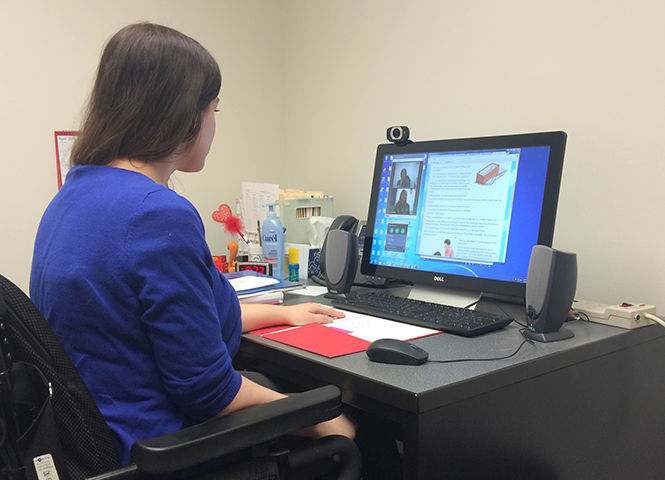Program introduces online therapy
Lauren Ledzianowski, a Speech Pathology graduate student, conducts a thearpy session using the telepractice system from her computer.
April 9, 2015
Through an inventive online videoconferencing system, Kent State’s speech pathology and audiology program is able to bring therapy sessions to students who are unable to receive traditional therapy.
Kent State has been using videoconferencing for the past eight years. The project was funded for three years by a grant from the Ohio Department of Education. With the grant, the telepractice project started and used research to determine if it works as well as traditional therapy.
Speech pathology and audiology data show that students respond well to the telepractice system and that kids have similar progress.
Preschool through high school students from Montpelier Exempted Village schools in northwest Ohio and Greenfield Exempted Village schools in southeast Ohio, who have identified communications impairment, are receiving speech-language therapy services through Kent State’s telepractice project.
Practices provided are live, two-way interactive videoconferencing. Therapists are able to bring up images that show on both screens, and the student can interact with these images.
Kent State faculty members Patricia Chafin and Robin Alvares, project coordinator in the Health Sciences department, have 20 minute therapy sessions with children five days a week.
“I was used to doing speech in a traditional way, in a little room with a table with activities you would touch” Chafin, a project coordinator in the Health Sciences Department, said. “You really can target the same things online; it’s different”.
Sessions are held individually or in small groups. Children at the school site are accompanied to their sessions by an assistant eHelper. Each session is tailored to help students with a specific language problem they are experiencing.
EHelpers ensure the technology is working properly and the children are in view of the camera. They also assist with any other troubleshooting duties that may occur.
Five to six Kent State speech pathology and audiology graduate students have been trained each semester to learn how to use the telepractice service delivery model to provide therapy services since 2008.
“It’s nice to get this experience because I would have never thought of something like this without telepractice. We are used to working in the physical environment, so to have something electronic and sharing like this and seeing it work so well,” said Lauren Ledzianowski, speech pathology and audiology graduate major.
The program plans to experiment with telepresence robots that will provide services directly within the regular education classroom. This will help increase collaboration among other professionals.
“We really want telepresence robots,” said Susan Grogan-Johnson, associate speech pathology and audiology professor. “We provide services directly to the kids, but sometimes it’s hard to get collaboration with other faculty and other professionals unless they stop down to the telepractice room or we call or email them. If we had telepresence robots, the robots could go into the classrooms and they could go visit the teachers. It would be one step closer to being physically present.”
Contact Katie Chilson at [email protected].

























